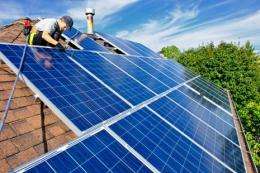More heat, more light: A step toward better solar energy systems

(Â鶹ÒùÔº) -- A Michigan Technological University researcher has made a solar cell that brings more to the rooftop: it’s good at making electricity, and it’s great at capturing heat to warm your home and your water.
Solar photovoltaic thermal energy systems, or PVTs, generate both heat and electricity, but until now they haven’t been very good at the heat-generating part compared to a stand-alone solar thermal collector. That’s because they operate at low temperatures to cool crystalline silicon solar cells, which lets the silicon generate more electricity but isn’t a very efficient way to gather heat.
That’s an economics problem. Good solar hot-water systems can harvest much more energy than a solar-electric system at a substantially lower cost. And it’s also a real estate problem: photovoltaic cells can take up all the space on the roof, leaving little room for thermal applications.
In a pair of studies, Joshua Pearce, an associate professor of materials science and engineering, has devised a solution in the form of a better PVT made with a different kind of silicon. His research collaborators are Kunal Girotra from ThinSilicon in California and Michael Pathak and Stephen Harrison from Queen’s University, Canada.
Most solar panels are made with crystalline silicon, but you can also make solar cells out of amorphous silicon, commonly known as thin-film silicon. They don’t create as much electricity, but they are lighter, flexible, and cheaper. And, because they require much less silicon, they have a greener footprint. Unfortunately, thin-film silicon solar cells are vulnerable to some bad-news physics in the form of the Staebler-Wronski effect.
“That means that their efficiency drops when you expose them to light—pretty much the worst possible effect for a solar cell,” Pearce explains, which is one of the reasons thin-film solar panels make up only a small fraction of the market.
However, Pearce and his team found a way to engineer around the Staebler-Wronski effect by incorporating thin-film silicon in a new type of PVT.
You don’t have to cool down thin-film silicon to make it work. In fact, Pearce’s group discovered that by heating it to solar-thermal operating temperatures, near the boiling point of water, they could make thicker cells that largely overcame the Staebler-Wronski effect. When they applied the thin-film silicon directly to a solar thermal energy collector, they also found that by spike annealing (baking the cell once a day), they boosted the solar cell’s electrical efficiency by over 10 percent.
The symbiotic process solves that real estate problem, making both the thermal and electrical side of the PVT more efficient. “People could have thermal and electrical energy in a neat little package,” Pearce said.
Because of that, he speculates that the next wave of solar cells will be PVTs.
“They give you the most usable solar energy per square foot of roof space,” Pearce said. “I think that 20 years from now, every roof will be made of integrated PVT.”
Pearce has published two articles on this research, “,” in the journal Solar Energy, coauthored with Pathak, Girotra and S. J. Harrison; and “” in the journal Solar Energy Materials and Solar Cells, coauthored with Pathak and Harrison.
Journal information: Solar Energy , Solar Energy Materials and Solar Cells
Provided by Michigan Technological University


















